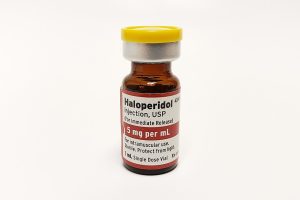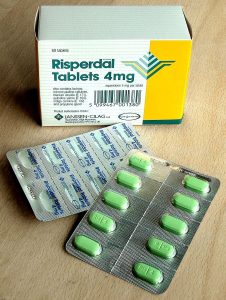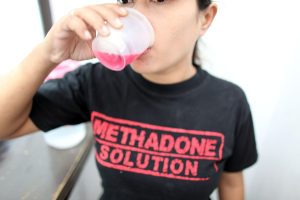10.4 Other Psychiatric Medications
Antipsychotic Medications
Antipsychotic medications are used to treat psychosis, schizophrenia, extreme mania, depression that is resistant to other therapy, and other central nervous system conditions. The symptoms of psychosis generally include delusions, hallucinations, bizarre behaviour, and inappropriate moods. Schizophrenia is the most common form of psychosis, though there are other types and causes, such as drug-induced psychosis. Antipsychotics are sometimes referred to as major tranquilizers because they produce a state of tranquility. Although the medications that were discussed in the section on anti-anxiety medications are referred to as minor tranquilizers, it is important to note that they are actually unrelated to major tranquilizers and work very differently within the body.
All antipsychotics block dopamine receptors in the brain; however, the precise mechanism of action is not clearly known. Conventional antipsychotics, such as haloperidol (Fig. 10.5), block dopamine receptors in certain areas of the central nervous system. These areas are associated with emotions, cognitive function, and motor function, and blockage produces a tranquilizing effect in patients suffering from psychosis. However, several adverse effects are also caused by this dopamine blockade.

Table 10.2. Potential Adverse Effects of Antipsychotic Medications
| Adverse Effect | Definition |
| Tardive dyskinesia | Involuntary contraction of the oral and facial muscles (such as tongue thrusting) and wavelike movements of the extremities |
| Neuroleptic malignant syndrome (NMS) | A potentially life-threatening adverse effect that includes high fever, unstable blood pressure, and myoglobinemia |
| Extrapyramidal symptoms | Involuntary motor symptoms similar to those associated with Parkinson’s disease; includes symptoms such as akathisia and acute dystonia |
(Ernstmeyer & Christman, 2020)
Second-generation antipsychotics, also referred to as atypical antipsychotics, have fewer adverse effects. An example of an atypical antipsychotic is risperidone (Risperdal) (Fig. 10.6). Second-generation, or atypical, antipsychotics block specific dopamine 2 receptors and specific serotonin 2 receptors, resulting in fewer adverse effects. Atypical antipsychotics may also cause metabolic changes such as hyperglycemia, hyperlipidemia, and weight gain.

ADHD Medications
Methylphenidate (Ritalin) and amphetamine (Adderall) are examples of central nervous system stimulants that are often used to treat ADHD. Both are thought to block the reuptake of norepinephrine and dopamine into the presynaptic neurons. They can also stimulate the brain and act similarly to amphetamines. These medications have a high potential for abuse and dependence, so they are highly controlled.
Anti-Mania Medications
Mood stabilizers are used to treat bipolar disorder. Lithium (Lithobid) was the first medication used to treat this disorder and is sometimes referred to as an anti-mania drug because it can help control the mania that occurs in bipolar disorder. Lithium alters sodium transport in nerve and muscle cells, but the specific mechanism of action is unknown.
Lithium must be closely monitored and has a narrow therapeutic serum range. Serum sodium levels should also be monitored for potential hyponatremia.
Addiction
- Irritability
- Sleeplessness
- Depressed mood
- Anger
- Cravings
- Sweating
- Nausea and vomiting
- Tremors
- Confusion
- Emotional and physical pain
Medications Used to Assist Withdrawal
Some medications can be given to assist with the withdrawal process from certain substances. For example, buprenorphine (Buprenex, Subutex) can be given to lessen the withdrawal symptoms from addiction to heroin, cocaine, and narcotic medications (WebMD, 2023). Methadone (Diskets, Dolophine) is another, often more common medication that is prescribed to assist with withdrawal. It can be given on a long-term basis to prevent re-addiction as well. Methadone is highly controlled, so when it is taken long term, individuals must go to a clinic daily to obtain their dose. Fig. 10.7 shows someone receiving their daily dose of methadone in liquid form. Methadone prevents withdrawal symptoms but does so in such a way that it does not produce the euphoria that was once achieved with substances such as heroin, cocaine, or narcotics.

There are also certain medications that can be used to treat withdrawal from alcohol. Acamprosate (Camprol) and disulfiram (Antabuse) are commonly prescribed but work quite differently than those medications discussed above (Web MD, 2023). Acamprosate helps to reduce cravings, and disulfiram produces nausea, chest pain, and sweating if someone ingests alcohol. Because of the unpleasant symptoms that result when mixing alcohol and disulfiram, those on the medication are inclined to avoid alcohol.
Table 10.3. Common Psychiatric Medications
| Generic Name | Trade Name | Reason for Administering |
| haloperidol | Haldol | Schizophrenia, mania, psychosis, Tourette’s syndrome |
| risperidone | Risperdal | Schizophrenia, bipolar disorder, psychosis |
| methylphenidate | Ritalin, Concerta | ADHD |
| amphetamine | Adderall | ADHD |
| lithium | Lithobid | Mania (bipolar disorder) |
| buprenorphine | Buprenex, Subutex | Withdrawal from heroin, cocaine, or narcotic drugs |
| methadone | Diskets, Dolophine | Withdrawal from heroin, cocaine, or narcotic drugs |
| acamprosate | Camprol | Alcohol withdrawal |
| disulfiram | Antabuse | Alcohol withdrawal |
(WebMD, 2023)
Attribution
Unless otherwise indicated, material on this page has been adapted from the following resource:
Ernstmeyer, K., & Christman, E. (Eds.). (2020). Nursing pharmacology. Chippewa Valley Technical College. https://wtcs.pressbooks.pub/pharmacology/, licensed under CC BY 4.0
References
University of Toledo Counseling Center. (2023). Tolerance and withdrawal. https://www.utoledo.edu/studentaffairs/counseling/selfhelp/substanceuse/marijuanatolerancewithdrawal.html#:~:text=tolerance%20is%20a%20physical%20effect,no%20longer%20having%20the%20substance
WebMD. (2023). Drugs and medications A–Z. https://www.webmd.com/drugs/2/index
Haloperidol 2 by Intropin (Mark Oniffrey), CC BY-SA 4.0
Risperdal tablets by Housed, CC BY-SA 3.0
HIV in Indonesia (10701445183) by Department of Foreign Affairs and Trade, CC BY 2.0
extreme emotional highs; often associated with bipolar disorder
fixed false beliefs that cannot be changed through reasoning
hearing, seeing, smelling, tasting, or feeling touched by things that are not there
the presence of myoglobin in the blood; often seen with excessive exercise
distressing motor restlessness and the need to move
painful muscle spasms
high blood sugar
high lipid levels in the blood
stimulant drugs that speed up the central nervous system
low sodium levels in the blood
a feeling or state of intense excitement and happiness

